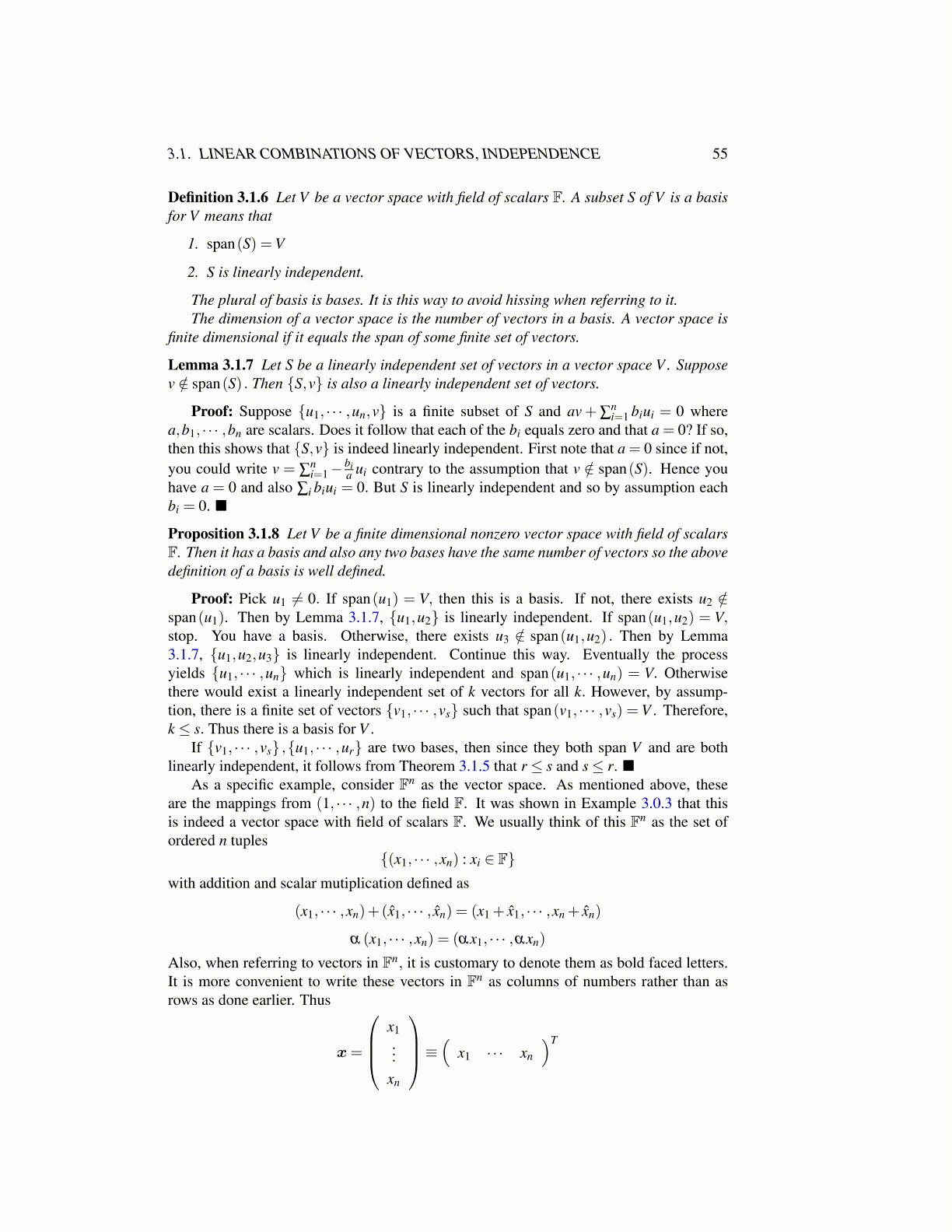
3.1. LINEAR COMBINATIONS OF VECTORS, INDEPENDENCE 55
Definition 3.1.6 Let V be a vector space with field of scalars F. A subset S of V is a basisfor V means that
1. span(S) =V
2. S is linearly independent.
The plural of basis is bases. It is this way to avoid hissing when referring to it.The dimension of a vector space is the number of vectors in a basis. A vector space is
finite dimensional if it equals the span of some finite set of vectors.
Lemma 3.1.7 Let S be a linearly independent set of vectors in a vector space V . Supposev /∈ span(S) . Then {S,v} is also a linearly independent set of vectors.
Proof: Suppose {u1, · · · ,un,v} is a finite subset of S and av + ∑ni=1 biui = 0 where
a,b1, · · · ,bn are scalars. Does it follow that each of the bi equals zero and that a = 0? If so,then this shows that {S,v} is indeed linearly independent. First note that a = 0 since if not,you could write v = ∑
ni=1−
bia ui contrary to the assumption that v /∈ span(S). Hence you
have a = 0 and also ∑i biui = 0. But S is linearly independent and so by assumption eachbi = 0. ■
Proposition 3.1.8 Let V be a finite dimensional nonzero vector space with field of scalarsF. Then it has a basis and also any two bases have the same number of vectors so the abovedefinition of a basis is well defined.
Proof: Pick u1 ̸= 0. If span(u1) = V, then this is a basis. If not, there exists u2 /∈span(u1). Then by Lemma 3.1.7, {u1,u2} is linearly independent. If span(u1,u2) = V,stop. You have a basis. Otherwise, there exists u3 /∈ span(u1,u2) . Then by Lemma3.1.7, {u1,u2,u3} is linearly independent. Continue this way. Eventually the processyields {u1, · · · ,un} which is linearly independent and span(u1, · · · ,un) = V. Otherwisethere would exist a linearly independent set of k vectors for all k. However, by assump-tion, there is a finite set of vectors {v1, · · · ,vs} such that span(v1, · · · ,vs) = V . Therefore,k ≤ s. Thus there is a basis for V .
If {v1, · · · ,vs} ,{u1, · · · ,ur} are two bases, then since they both span V and are bothlinearly independent, it follows from Theorem 3.1.5 that r ≤ s and s≤ r. ■
As a specific example, consider Fn as the vector space. As mentioned above, theseare the mappings from (1, · · · ,n) to the field F. It was shown in Example 3.0.3 that thisis indeed a vector space with field of scalars F. We usually think of this Fn as the set ofordered n tuples
{(x1, · · · ,xn) : xi ∈ F}with addition and scalar mutiplication defined as
(x1, · · · ,xn)+(x̂1, · · · , x̂n) = (x1 + x̂1, · · · ,xn + x̂n)
α (x1, · · · ,xn) = (αx1, · · · ,αxn)
Also, when referring to vectors in Fn, it is customary to denote them as bold faced letters.It is more convenient to write these vectors in Fn as columns of numbers rather than asrows as done earlier. Thus
x=
x1...
xn
≡ ( x1 · · · xn
)T